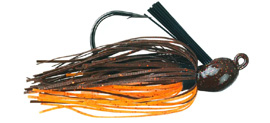All About Bass Fishing - Guide To Fishing Deep With Jigs
By Rick Seaman and Dan Westfall

Jigs are a primary weapon for deep-water bass fishing. They can be fished weedless or open-hook, depending on the cover you encounter. When bass are active, this is a way to cover lots of water in a hurry. When the bass are inactive, this is a way to cover less water more thoroughly.
3 Most Important Factors About Fishing Deep With Jigs
- Finding cover on outside structure is the key to finding good jig fishing water.
- Choose heavier jigs for fishing deep, one-half ounce to one ounce.
- Use a fishing rod designed for heavy lures, and use heavy line.
3 Most Effective Fishing Methods
- Must allow the lure to hit bottom after every movement – watch line to see it relax.
- Visualize your jig as a live crawfish swimming in and around cover on the bottom.
- Start fishing the jig at a fairly rapid pace pausing only to allow the jig to touch bottom, and go again.
Jigs are a primary weapon for deep bass.

It is believed by most bass anglers that a jig represents a crawfish. Jigs tend to be most effective when imitating crawfish. Crawl, hop and swim the jig on structure, in and around cover to appeal to bass. The speed of the fall and retrieve, plus the action you impart with rod movement should match the mood of the bass. When they are actively feeding, a faster movement is best. When they are inactive a slow, quiet retrieve is more appropriate.
To fish faster, use heavier jigs if the bass are active. For less active bass use lighter jigs. Match the line and rod to the weight lure you’re fishing. Use a minimum of 12-pound line, preferably 14 or 17 pound – possibly heavier if you are fishing in dense cover. Whenever possible, fish an open-hook jig. If cover dictates otherwise, use a quality, weedless jig.
Jigs are made of three primary components. The jig head (hook and weight), the jig skirt and trailers. Select skirts and trailers to achieve the color and size jig appropriate to fishing conditions. In murky water use dark, bold colors and lighter, more natural colors in clear water. The combination of skirt and trailer create a size and shape for the bass to see. In dirty water, use bulky lures that move lots of water. In clear water, smaller, more natural profiles may attract more bites. To get additional attention, especially in dirty water, you can experiment with jigs that contain rattles.
A great way to begin fishing is the Westy Retrieve. Do this by letting the jig settle to the bottom and immediately crank the reel handle three times as fast as you can, then stop and allow the lure to return to the bottom. Repeat over and over until you are ready to bring it in for another cast.
AA Bass Fishing Knowledge Base
- Bass Fishing Overview
- Life Cycle Of Bass
- Seasonal Bass Migration
- Bass Migration - Mid to Late Winter
- Bass Migration - Spring
- Bass Migration - Early Summer
- Bass Migration - Late Summer
- Bass Migration - Fall
- Bass Migration - Early Winter
- Fishing For Bass
- It's Now WHAT You Throw, It's WHERE
- Research The Fishery Before You Go
- Review Contour Maps
- Types Of Cover Used By Bass
- Bass Fishing In Grass Beds
- Bass Fishing In Wood & Timber
- Bass Fishing In Brush & Vegetation
- Establishing Patterns
- Learn To Recognize Bites
- Review Lunar Tables
- Choose The Right Lures
- Find Bass Based On Conditions
- Conditions - Fold Fronts
- Conditions - Wind
- Conditions - Cloudy Days
- Conditions - Fishing In The Rain
- Conditions - Water Clarity
- Conditions - Rising Water
- Conditions - Falling Water
- Conditions - Fishing At Night
- Equipment & Tackle
- Equipment - Fishing Rods
- Equipment - Fishing Reels
- Equipment - Fishing Line
- Equipment - Fishing Lures
- Fishing With Live Bait
- Shallow Water Techniques, 0 -10'
- Shallow Fishing - Spinnerbaits
- Shallow Fishing - Crankbaits
- Shallow Fishing - Top Water
- Shallow Fishing - Pitching & Flipping
- Shallow Fishing - Artificial Worms
- Shallow Fishing - Jigs
- Shallow Fishing - Flukes
- Shallow Fishing - Stick Worms
- Shallow Fishing - Swimbaits
- Fishing Mid Range Depths, 10' - 25'
- Mid Depth - Spinnerbaits
- Mid Depth - Deep Diving Crankbaits
- Mid Depth - Artificial Worms
- Mid Depth - Jigs
- Mid Depth - Swimbaits
- Fishing Deep Water & Structure
- Fishing Deep Water - Jigs
- Fishing Deep Water - Jigging Spoons
- Fishing Deep Water - Artificial Worms
- Planning Your Attack
- Bass Fishing Questions & Answers
- Conservation - Protect The Fishery
Bass information by state.
Fishing Information



